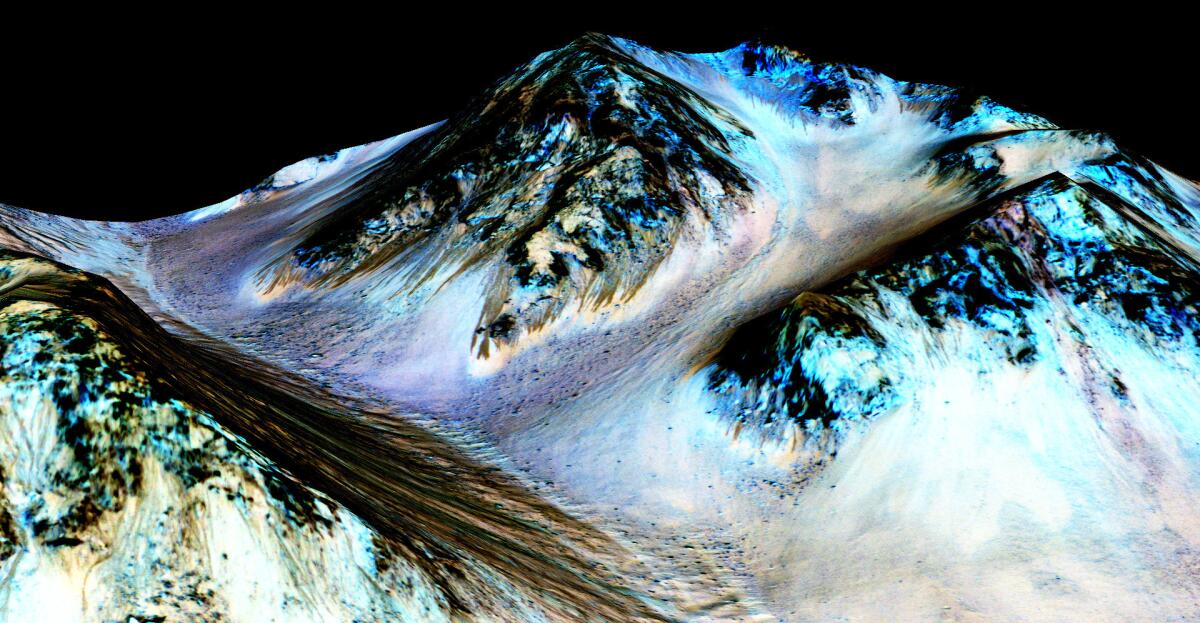Red Planet discovery has scientists seeing stars

In this handout provided by NASA’s Mars Reconnaissance Orbiter, dark, narrow streaks on the slopes of Hale Crater are inferred to be formed by seasonal flow of water on surface of present-day Mars. These dark features on the slopes are called “recurring slope lineae” or RSL. Scientists reported on September 28, 2015 using observations with the Compact Reconnaissance Imaging Spectrometer on the same orbiter detected hydrated salts on these slopes at Hale Crater, corroborating the hypothesis that the streaks are formed by briny liquid water.
NASA’s announcement this week confirming the presence of liquid water on Mars sent ripples of excitement through the scientific community about the potential implications for future manned missions to the Red Planet and the viability of life there.
Now locally, scientists and engineers at La Cañada’s Jet Propulsion Laboratory are imagining the many ways that possibility might shape the future, and funding, of scientific work planned for Mars in the coming decades.
NASA scientists and administrators broke news of the discovery in a press conference held Monday in Washington, D.C. Panelists explained how streak-like features — recurring slope lineae, or RSL — previously observed by the Mars Reconnaissance Orbiter on slopes across the planet’s surface, seemed to form and grow in late spring and summer and then stop, or freeze, in cold seasons before disappearing altogether.
The streaks behaved like liquid, but scientists had no idea as to their source or how a substance could remain in a liquid state in the Martian atmosphere, explained Alfred McEwen, NASA’s principal investigator of the HiRISE camera installed on the orbiter.
“These features are very sensitive to the temperature, they form at different times, at different latitudes on Mars, all related to the seasonal variations at those locations,” McEwen said Monday. “But we had no direct detection of water. That was just our best guess as to what these were.”
The mystery was first observed in 2010, when University of Arizona undergraduate student Lujendra Ojha was validating high-resolution images captured by HiRISE and noticed the streaks’ changing seasonal behavior.
In the Martian atmosphere, the thermal window in which substances can remain liquid is so narrow, scientists posited that RSL might contain high levels of a stabilizing material, such as salt.
Analysis performed by a spectrometer on the Mars orbiter seemed to support the theory that perchlorate salts on the Martian surface could be absorbing moisture from the atmosphere and becoming completely hydrated into briny flows, Ojha, speaking by telephone, explained in Monday’s press conference.
“The presence of hydrated salts in these slopes means that these features are forming into contemporary liquid water,” said Ojha, now a graduate student at the Georgia Institute of Technology and lead author of the report “Spectral evidence for hydrated salts in recurring slope lineae,” published Monday in the journal Nature Geoscience.
Mary Beth Wilhelm, a researcher at NASA’s Ames research center in Silicon Valley and a co-author of the study, said the existence of water on Mars, even highly briny water, could decrease the cost and increase the resilience of human activity on the Red Planet.
“Looking forward, it is imperative for us to further understand the source of water for these features as well as the amount,” Wilhelm said.
In an interview Tuesday, Richard Zurek, chief scientist for JPL’s Mars Program Office, agreed that RSL activity would play a pivotal role in the Mars 2020 mission, which will be designed to collect samples for return to Earth, as well as future orbiter and human missions in decades that will follow.
“We’re doing what we can to identify resources on the planet, water being a key one,” said Zurek, who helped launch the Mars Reconnaissance Orbiter in 2005. “What this (discovery) does is maybe suggest some places that are better than others, where it might be better to look for life.”
Zurek said Mars exploration funding would have to be maintained, and eventually increased, if NASA is to follow up on the promising leads discovered so far.
“If we’re really serious about sending humans to Mars, that’s going to require a whole new effort,” he said. “There will come a point where you have to invest in that as a national priority, perhaps an international priority.”
After Monday’s press conference, Rep. Adam Schiff (D-Burbank) issued a statement urging his fellow members of Congress to ensure full funding of the Mars Exploration Program.
“The news that water is flowing on the surface of Mars — not in the distant past, but today — is huge,” Schiff stated in the release. “It’s my hope that this discovery will help to ensure that Congress fully funds the Mars Exploration Program, and that the administration keeps the Mars 2020 mission on track.”
Zurek said Tuesday the recent findings spawn more questions than they answered.
“There’s much to be learned, and serendipity plays a big role in the steps forward,” he said.
